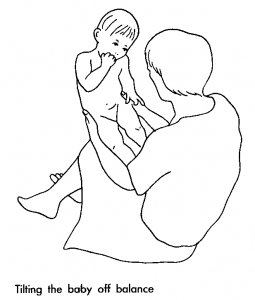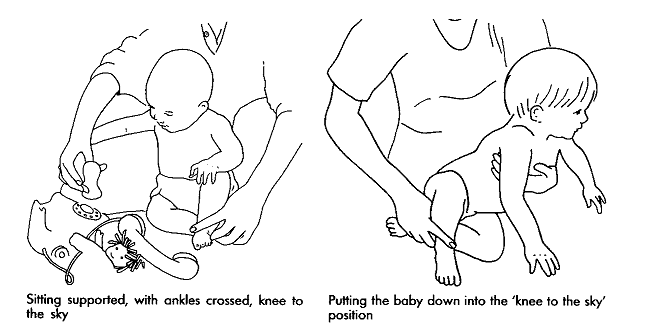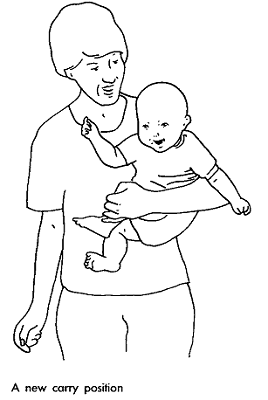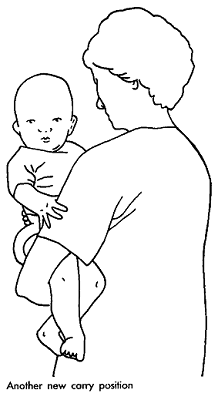GM.A.25 SITS UNSUPPORTED FOR 1 MINUTE
When she first sits by herself, the baby leans forward on bent hips with a wide base of support. She either props herself with her arms forward or braces herself up and back with her arms held bent in a high ‘W’ position in line with her shoulders.
She is not yet able to use her hands for play while sitting, as she needs them for support.
How to Assess
Method: Place your child in a sitting position on the floor, without support. Score plus if she maintains this position for 1 minute.
How to Teach
Several techniques can be used to teach the child to sit. Sit your child on top of a large beach ball and hold her hands on her knees, legs together. Slowly roll the ball from side to side and forward and backward.
At the extreme of each position she should tilt her head, shoulders and trunk back towards the midline. Try tilting her back at an angle, so that she also has to bring 1 shoulder forward to help correct her balance.

Next, sit your child, legs together, on your knees, holding her firmly around the hips. If she continually falls forward towards you, turn her around so that she is facing away from you. Slowly raise 1 knee slightly to tip her to one side – wait for her to tilt back to the middle. If she doesn’t attempt to pull back to the middle, raise your knee a little higher so that she really feels as if she will fall if she doesn’t tilt back. If she still makes no attempt to straighten up, then use the hand on the side to which you’re tilting her to tap her back to the midline from the lower shoulder. You can see once more that the weight-bearing side is the longer side.
This can also be done with you sitting on the floor with your legs out straight or bent. Sit the child on your thighs or knees and slowly raise each thigh alternately to tilt her off balance.
In each of these positions, also practise trunk balance reactions in a forward, backward and diagonal plane. Tilt the child forward, but at an angle, and wait for her to tip her head back and pull her shoulders and arms back to regain the upright position. When tilted back and at an angle, she should bend her head forward, chin to chest and round her shoulders and arms forward, bending at the waist, bringing 1 shoulder forward of the other. These movements are automatic when sitting is fully established.
Continue to sit your child unsupported on the floor, as described under How to Assess, so that you can see how the exercises are improving your child’s balance in sitting. Keep up the balancing exercises above until your child can right herself quickly, whenever she needs to, to prevent a fall.
Positioning, Carrying and Playing
So that she can continue to practise sitting when you are not with her, place her in a strong cardboard box with a sort pillow wedged between her and the sides and back of the box and toys in front of her in the box to play with. The box should not be so high that she can’t see over the top. Leave her in it, close to where you are working in the kitchen or outside on the grass. It should be sufficiently wide to allow her to tip over to the side and be at approximately a 45° angle when against the edge or the box, or to the same degree backward. If she tips over, the sides give her support and give her a chance to sit back up by herself. You can use a laundry basket or a bassinet in the same way. Remember, her legs must be together.
It is important to mention here that sitting can become a trap for low-toned babies. Parents can be so excited by the fact that their baby is close to sitting that they spend a lot of time on this skill and neglect the others. This is understandable, but should be avoided, and the baby should still have plenty of opportunities to practise learning to move on the floor.

A new position can now be used for short periods during the day. Again, it is a modified crisscross ankles, knee to the sky. This time, the child is to sit up higher, leaning on a support, for example a small cardboard box or a foam block. She can lean on either a bentor a straight arm, but remember to build in the twist – that is, opposite shoulder and hip facing towards each other.
Your child could also now be put down into this position.
It is advisable to keep your baby in her wristbands while she is learning to sit, so she has to use her trunk muscles and does not become dependent on widely spread legs for balance.
It is preferable to still sit her in the ‘ankles crossed’ position described in GM.A.12, GM.A.20 and GM.A.21 when you sit her on your lap.
It is now time to introduce 2 new carry positions. Hold her as for GM.A.8, but now bend up her outside leg. It is important to separate her two legs now, in preparation for crawling. Remember to build in the twist between her shoulders and hips.
The other position is to have her facing you, both legs tucked under your arm. She ‘sits’ on your forearm, your other hand supporting her lower back.


